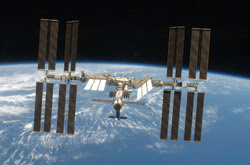
Letters to the Editor
White Elephant in Space?
 Many view the International Space Station (“Solar-powered space station,” Photonics Spectra, July, p. 36), as a $150 billion “white elephant” in space that has sucked resources from many other more worthwhile programs – construction that was said to have been created in part to provide jobs for out-of-work ex-Soviet nuclear scientists so they would not run off and give atom bombs to rogue states.
Many view the International Space Station (“Solar-powered space station,” Photonics Spectra, July, p. 36), as a $150 billion “white elephant” in space that has sucked resources from many other more worthwhile programs – construction that was said to have been created in part to provide jobs for out-of-work ex-Soviet nuclear scientists so they would not run off and give atom bombs to rogue states.
That it needs 32,800 solar cells is no brag. The same job could have been done with a plutonium energy cell the size of a home computer box, and it would not be relying on the sun to function.
Richard Anderson
Toronto
A solar fraud?
In the July issue of Photonics Spectra I read “Solar from space” (page 35). This concept is a complete fraud to get money for nonsense.
First, why is it so necessary to send power to Earth from space? Do we not have enough from fossils or other sources? One reason given is that it is often cloudy, so solar power plants cannot generate enough power.
If you look at pictures of the globe sent from a Meteo geostationary satellite, you can easily see that only about one-eighth of the half-globe is covered by clouds. This means that the remaining seven-eighths has unlimited solar irradiation, and we have terrestrial power networks to transport the generated power around the globe.
Next, consider that solar cells are quite inefficient; today’s best are at about 15 percent, and they age in space. Satellite designers know better. In my opinion, heating water is more efficient, and it is done in California, Arizona, Spain, Japan and elsewhere without rocket technology.
Then there’s the issue of energy loss as power is transmitted to Earth. Anyone who has heard about electromagnetic waves knows that the power decreases due to propagation in proportion to inverse square. In a power distribution, a “good” efficiency is more than 80 percent. The experts claim that the power will be focused and collected by huge antennas. A typical good satellite antenna has about 50 percent efficiency. And the free-space power loss at 2.45 GHz over 35,000 km is ~190 dB, otherwise 1020. What kind of power efficiency can you expect?
Finally, I have asked some of the experts how to get those wonderful antennas that amplify power. I would use them in microwave and millimeter-wave communication systems. Nobody has responded. All this is a hoax and pure fantasy, and moreover not based on natural laws. Those space solar concepts are pure nonsense.
Jiri Polivka
Santa Barbara, Calif.
Editor’s response: As a science writer, I cover subjects that I think will be of interest to our readers and make no claims as to the success of a technology or marketing concept. We do, however, appreciate readers keeping us informed of the many issues surrounding such a controversial topic.
Thin-film question
I read with great interest Caren B. Les’ article in the July issue on p. 28: “Image sensor market: Looking forward to better times.” I am curious about a statement in your article: “A third generation of devices based on polymeric thin films … also could be developed.”
Are there companies or start-ups in this space?
Erik Bodegom
Professor of Physics
Chairman, Department of Physics
Portland State University
Portland, Ore.
Response: I’m not sure of any companies that might be involved, but think PARC [Palo Alto Research Center] and the University of California, Santa Barbara, might be working on polymer-based image sensors.
Charles E. Spear
IntertechPira
Portland, Maine
Published: September 2009